Palais de Reine: hidden gem of the otome market
Palais de Reine is an strategy otome that was originally released back in 2006; it received a surprise localisation by Degica in 2020.
Its developer Kogado Studio is well-established and primarily known for its visual novels, of which Symphonic Rain, Yumeutsutsu and the Nurse Love series have previously been localised.
But Palais de Reine stands out from their previous work with its focus on kingdom strategy gameplay — it adds a surprising amount of complexity and depth to this hidden gem that, thankfully, has not been lost to time.
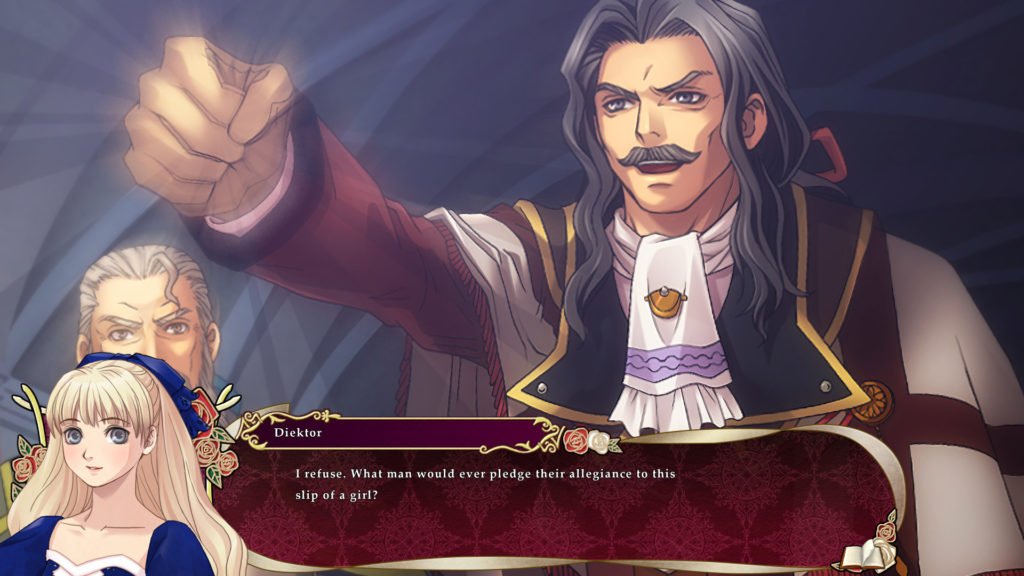
We are put into the position of Filia, whose father has passed away, and whose brother has gone missing. As the sole heiress to the kingdom of Losange, you put your best step forward to take the throne. The only problem is, not every noble in the kingdom believes you are up to the challenge of being queen. Will Filia be able to prosper in a mere year with the aid of her closest advisors and supporters? And just who will those be who side with her?
Palais de Reine had a sudden release on Steam in June of 2020, and I couldn’t be any more grateful for it — though it’s not particularly well-known, sadly. As of now, we still tend to hear the same old otome recommendations for PC gamers time after time — Amnesia, Nightshade, Hakuoki, London Detective Mysteria… the list goes on, with ports making up the bulk of the list. PC exclusives are even more sparse, consisting of titles such as Dandelion, Nameless, OZMAFIA and Taisho x Alice being examples of the most recognisable localised titles.
Very rarely do we ever see Palais de Reine mentioned, and in some ways this is not altogether surprising. Despite fitting neatly into the otome category, Palais de Reine is unorthodox and differs greatly from the genre’s staples — even despite having originally come out back in 2006.
The “kingdom strategy” gameplay of the title makes for a refreshing and challenging kind of otome experience unlike many other titles on the market — and the game simply did not reach enough interested players with its quiet release.
It is a true shame, so here I am once again to spread the word on a game I firmly believe should have a wider audience, even if one of its primary focuses might not be to your usual taste as an otome fan. It is a kingdom management game first and foremost after all — but I’m always more prone to romance, so let’s tackle that aspect first.
A little bit of romance never hurt anybody, right?
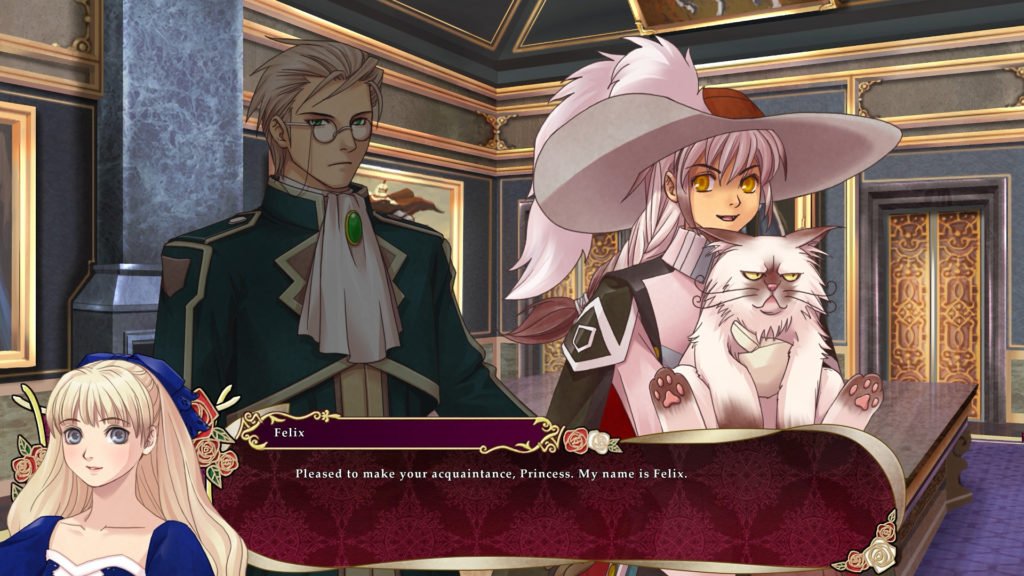
Palais de Reine did get two fandisks, titled Palais de Royale, and Palais de Carnaval. While it’s probably best not to think about whether or not these will ever get localised, Palais de Reine will, in itself, keep you far too preoccupied to give it any further thought.
And this is no exaggeration, as it can easily take well over 130 hours to experience the entire game. It will take multiple playthroughs to romance all of the potential suitors — and with well over 30 characters to bond with, each with their own endings even if they are not romanceable, the heavy load of content here makes the game an absolute timesink.
And I couldn’t be more pleased with this fact; it gives you plenty of bang for your buck, but also produces a layered story where the more you learn about and understand the characters, the more plot points you discover, and the more well-realised the world starts to feel.
So when I say “a little bit” of romance, I mean “potentially a whole lot” depending on how much time you dedicate to the game — and if romance is a major interest of yours.
Since the game has such a massive amount of potential love interests, each one has a varying amount of events and relevance to the plot. Certain knights are more integral to the narrative compared to other characters, for example, making these love interests more fleshed out than others.
This does make the many replays more manageable — but it can also feel a little lacking if your favourite love interest does not have as much screen-time as the others. But thankfully, each and every character with a backstory further adds to the detail and impact of Palais de Reine’s plot, making for a fully realised, thriving and immersive world.
Palais de Reine excels at appealing to a wide audience, particularly in the otome sphere, and I always like to see this. I have previously mentioned my fondness for Sweet Fuse including an unusual love interest pool — all the potential lovers in that game are somewhat unconventional in looks and varying levels of attractiveness. (Urabe is bae – Ed.) It makes Sweet Fuse all the more unique for its differing approach to the genre, while providing players with very different choices for lovers that encompass many different types, ages and builds.
Palais de Reine goes even further than this with its character designs. As the game is set in a medieval, fantasy world, you can romance a wildly diverse cast of characters, with vastly different races and even species, consisting of older gentlemen, a vampire, a deceased Lord, a werewolf, and even that most mysterious archetype of all: women. What a mix.

To make picking a love interest easier for players, many familiar character tropes are quickly distinguishable.
The childhood friend of Astrud is possibly the easiest to identify as a trope, with his youthful and energetic disposition around the Princess — he has a very apparent crush on her. But he makes for just as much of an immediate reminder that the characters are much more deeper than they may appear, since he also has an engrossing and emotional narrative route with wider connections to the war-torn state of its world.
More examples include the shota Elliot, who contrasts enormously to the burly, brawl-ready and comedic Wentzel — and the token flirty love interest Evangile is yet another walking archetype. But after learning more about each of their characters beyond the basic tropes they embody, you’ll find yourself adoring each and every one of them for their unusual quirks and surprising amounts of depth.
From princess to queen
While the romancing is, of course, a prime selling point of Palais de Reine, the game can be played without ever considering this side of the title. Because its kingdom management mechanics makes up the bulk of the gameplay and narrative, the choices made in these segments is what progresses the game.
Palais de Reine does not offer a happy ending if you fail the kingdom strategy segments, in other words. While bypassing the romancing is optional, anyone playing for the love interests has to go into the title with the knowledge that claiming victory on the battlefield is the only way to obtain the man of your dreams. We’ve got a kingdom to rule over first and foremost, and a young queen must prioritise her royal duties over passing fancies!
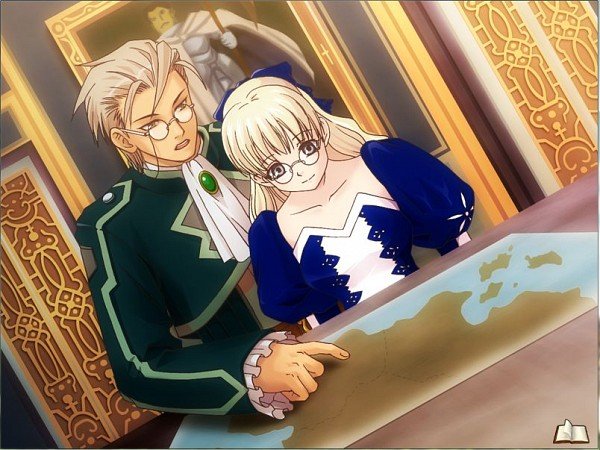
On a significant note, the always polarising topic of what makes a good heroine is of course relevant to this section. And I’m very pleased to report that Filia is yet another great example of a heroine done well. As Filia is of the tender age of 15 when the story starts, her lack of knowledge in royal duties and the responsibilities involved in running a kingdom makes her quiet consideration and willingness to listen to those around her understandable and believable.
Choices are very frequent, and at most offer three selections. These selections always encompass a different tone and projection, whereby Filia can sound short and brash, confident and assertive, charming and flirtatious, or reserved and stoic. While many events often remind the player of Filia’s young and innocent ways, such as her playfulness around Astrud, the story is quick to reinforce the harsh reality of its world, such as units potentially being lost forever if they are not victorious on the battlefield. In this way, Palais de Reine manages to cover so much ground to appeal to a wide audience with its balance in sensibilities.
A kingdom needs its queen
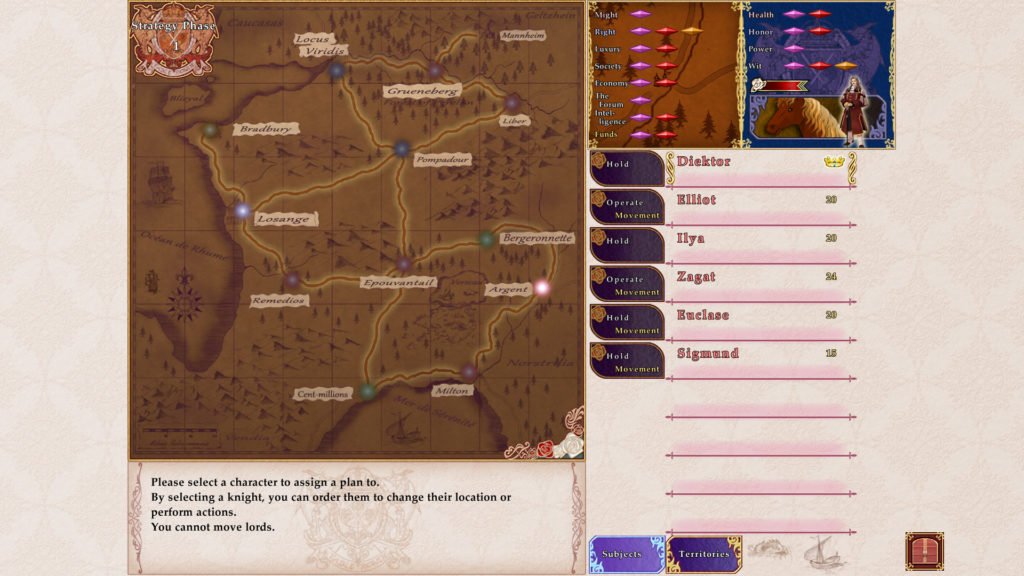
As previously mentioned, the romance can take a backseat and does do so for its plot to be the major focus. And for this grand plot to develop, the incredibly important Kingdom management mechanics is our next port of call. At the beginning of the game, we have the option to hire three knights out of the 27 available, with the remaining ones becoming available to hire during the rest of the playtime.
It’s important to keep an eye on your funds when approaching more recruits, alongside improving your honour rating. Increasing your honour increases your capacity to hire new knights — and this is not only necessary to make swifter progress on traversing the map, but to provide more options in increasing affection with your units.
There are a wide range of options when it comes to allocating actions to the Knights, such as operating in an area to possibly trigger new scenes, or searching locations for items that can be gifted to others. Talking to neutral or enemy knights can make them consider approaching you for hire, while training with others improves their stats; this is a very valuable option when increasing Filia’s honour skill with someone else who ranks highly in it.
Duels need funding to commence; here, your knight duels with a lord or another knight, and if Filia’s Knight wins, the opponent will ally with you.
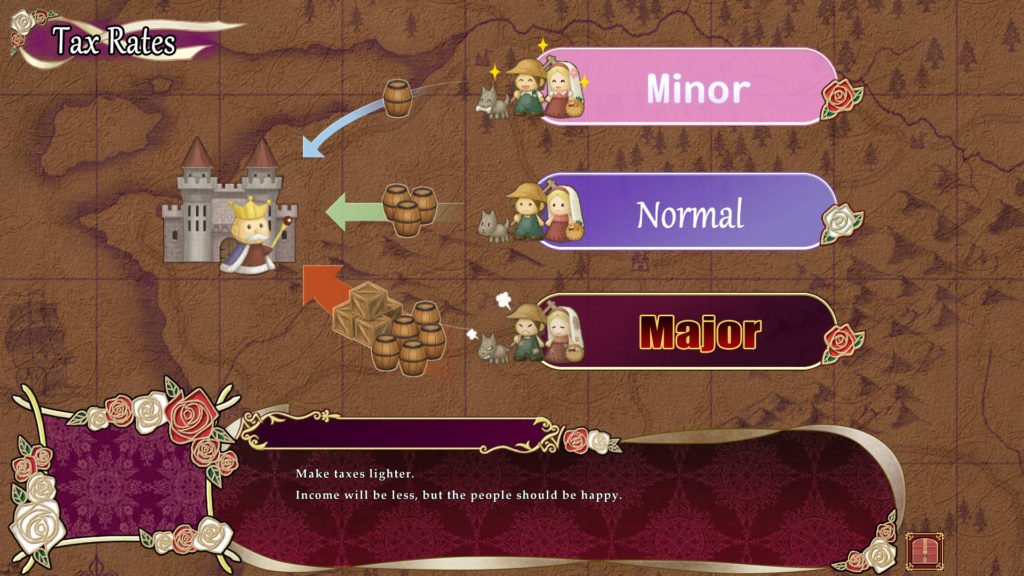
It should be quite evident at this point that funding is one of the most important aspects of the game to keep an eye on, as it can be very easy to mismanage. Taxes and funds have to be set with each turnover, and this can also affect the potential of a revolt happening in Filia’s domain. These revolts will also happen across the map and can be suppressed by other knights or, more optimally, your own units; this will help others’ perception of your your nation their willingness to support you.
Funds can be requested by other lords, or you can donate to them. Likewise, Filia can also request funds, or if she really must, she can even order an assassination of a lord if the going gets too tough. And finally, gifts will be your saving grace to rack up affection points; these can be found by knights during their search actions, or purchased from a merchant. They can then be gifted to lords or knights.
My rundown of the primary mechanics of the game may already sound far too much to get your head round — and the game’s tutorial given by our trusty (and adorably brilliant) advisor Winfried can be just as difficult to make sense of in your early hours with the game.
But after playing through only a few turns, the mechanics you’ll be mostly relying on will become evident and it’s all clear sailing from here… for the most part. There are, after all, two difficulty settings available – normal and hard. And the normal setting is tricky enough due to the issue of managing funds being especially troublesome; the challenge is still greatly appreciated for an otome game.
But on top of all this, there are secret knights who are unlocked through specific triggers, and a variety of other unlockable content such as character events, gifts, music and scenes to discover.
A brilliantly flawed princess simulator
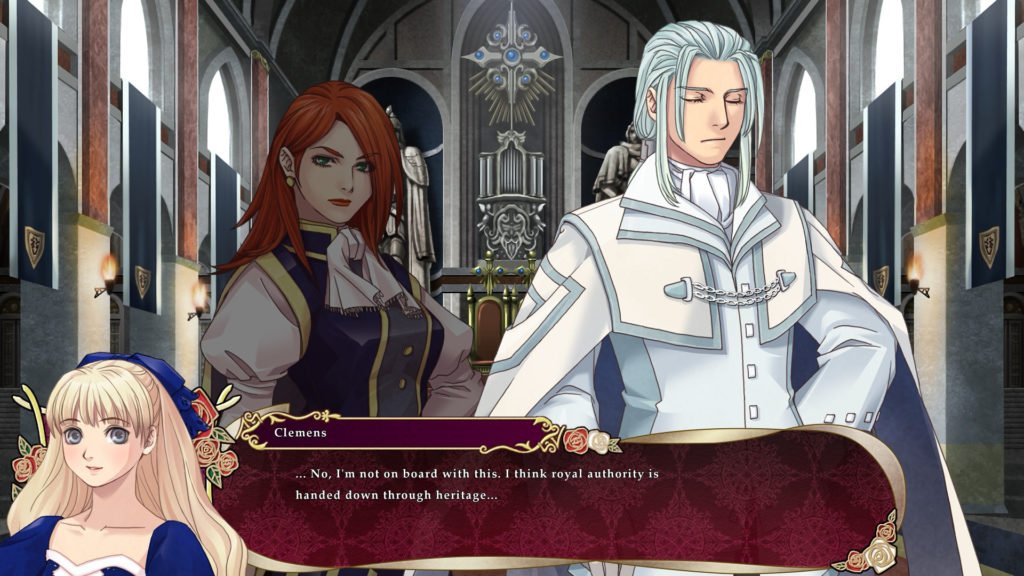
Despite how much I adore this title, it is not without its few notable setbacks. These are primarily a result of the fact this game originates from 2006, but they’re worth mentioning nonetheless.
Out of the two performance issues I have ran into, perhaps the most important one to note is an issue of full-screen optimisation. The game is rather rigidly coded to run at 1920×1080 and can run into issues if you’ve set custom zoom or DPI settings in Windows; a bit of tinkering is required if you’re running on a different display size.
The game also has a habit of being quarantined depending on what antivirus software is running on your system. While the game is safe to run, the flagging up of it as a malicious file has yet to be fixed by the developers as of now, making it tedious to run into the same problem after booting Steam back up each and every time.
And while I have praised the amount of features that have been packed into the game, it can also be seen as a weakness. Filia, while highly adaptable to our preferences to reflect our own personality, leaves many blank spaces to truly capture and make us understand her as a character in her own right. She does not really have her own traits, and we do not know of her own thoughts or perceptions of events. We simply shape her personality and use her as a self-insert. Along with this lack of main character development, the wide variety of character narrative threads and endings can also be a bit of an issue.
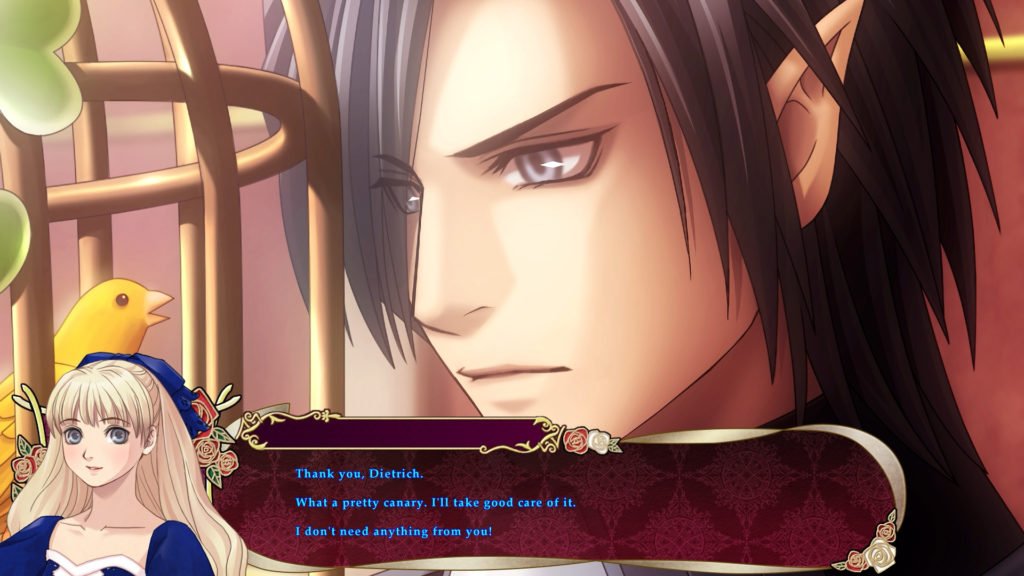
Every single romanceable character is likable and has their own backstory, hardships and motivations, but we cannot and do not have enough time to see all of these stories progress and flourish as we have a kingdom to run and a main plot to witness that always takes greater importance.
Possibly the most detrimental outcome of this focus is seen during the confession scenes. Sometimes these can be extremely sudden if the player has not seen as many events as possible to add a sense of substance to the relationship. It all feels rather short and brimming with untapped potential; the game never feels like it has quite enough time to commit fully to anything; you’ll need many replays to pack in all the additional character scenes and endings. But all this could simply be because Palais de Reine is a product of its time.
When we consider how old the game is, its UI is not the most polished or neat, making navigation awkward until you’ve played enough to become familiar with it. And while the low budget of the game is understandable, it is also worthwhile noting how voice acting is not frequent nor is it applicable for everyone. Seven of the knights, two of the lords and Filia’s two assistants are voiced, but not every scene with them in it is fully voiced. While this is a bit of a forgivable nitpick, the game’s attention to detail is lacking in a few other notable departments which some might find a lot more distracting.
Notably, the character portrait of Filia does not show different expressions no matter the scene or situation, and the option of skipping dialogue by using the Control key also skips over new text; this can be a pain when replaying segments hoping for a different outcome.
But possibly the most criminal design decision is the fact that there is no CG gallery. Considering how many runs you have to play to see all the CGs the game has to offer, having them locked within the crevices of our memories (unless we remember to frequently save before unexpected events featuring CGs) is a very sad oversight.
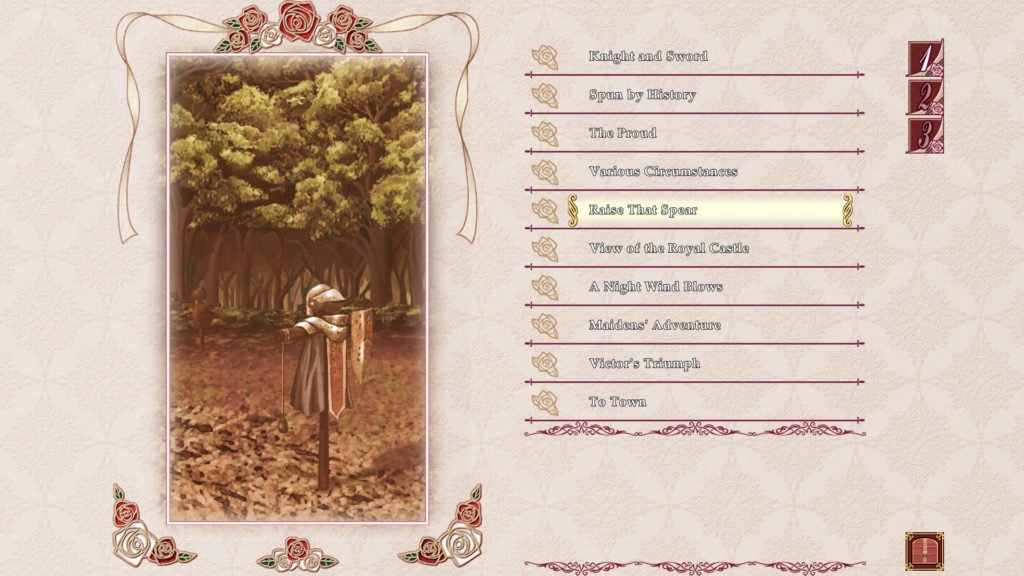
And finally, there is one other gameplay mechanic I had not yet mentioned due to its poor implementation. Free time feels redundant, since many locations don’t really change over time; more could have been done to either indicate areas with new activity, or simply allocate this time for something simpler but more relevant to gameplay, such as purchasing items from the merchant.
Conclusion
But in the end, despite its shortcomings, Palais de Reine has managed to completely take my heart.
It attempted a feat unlike anything else I have seen localised within the otome sector — and considering it comes from all the way back in 2006, it is truly a delightful surprise indeed. It offers a thoroughly engaging royal coming-of-age story for everyone and anyone to enjoy, even outside of the romantic aspects.
And for anyone who has similar tastes to mine, this is undoubtedly a must-play. Hopefully Palais de Reine gets more chances to succeed than it has had to date.
So on a final note, I beg of you; head on over right now to Steam and support the game immediately!
Join The Discussion
Rice Digital Discord
Rice Digital Twitter
Rice Digital Facebook
Or write us a letter for the Rice Digital Friday Letters Page by clicking here!
Disclosure: Some links in this article may be affiliate links, which means we may earn a small commission if you make a purchase after clicking on them. This is at no additional cost to you and helps support Rice Digital!
- Sigh of the Abyss: Shadow Bonds – Prologue Review - October 7, 2023
- Is She The Wolf? is wickedly addicting TV - October 6, 2023
- The steady consumption of Slow Damage - October 5, 2023






